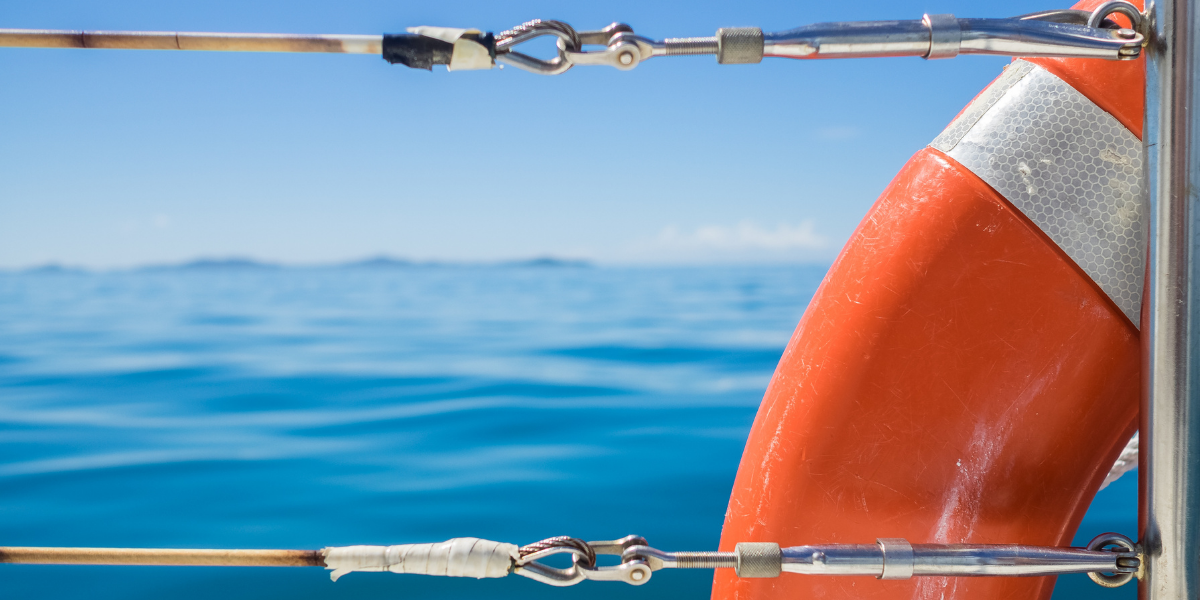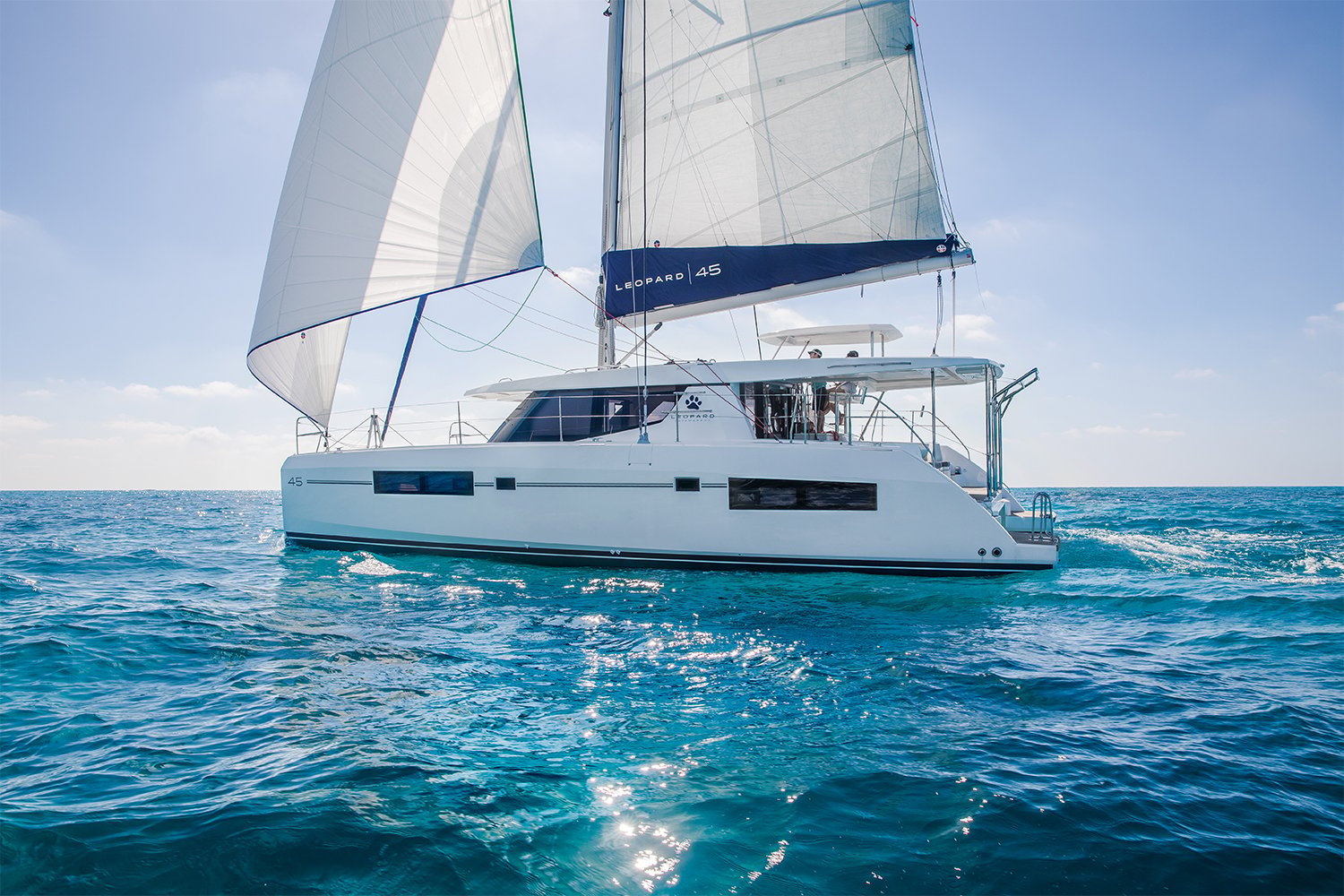Sailing is an adventure, and all adventures should be taken seriously. Proper planning is key to ensure that you and your guests are safe out on the water, should anything turn unfavorable. As the saying goes, it is better to be safety conscious than to be unsafe and unconscious.
The team here at Leopard Catamarans has pulled together some of our best advice for ensuring safety at sea, whether you are going out for the day, crossing over to the Bahamas, or crossing the Pacific.
1. Predeparture checklist
Review the checklist prior to your departure and ensure that it has everything that is required by the USCG. Onboard, there should be a PFD (personal flotation divide) for every passenger, noise and visible distress aid such as flares and a horn, a throwable flotation device, local emergency contact information, a working VHF radio, a fire extinguisher, and a proper first aid kit.
After you take inventory of your safety gear, take time to walk around the boat. Examine the running and standing rigging, look in the bilges, check the float switch and the battery meter, finally open the engine compartments so you can check your oil and coolant levels. Now might also be a good time to check and make sure your registration and insurance is up-to-date. If everything looks good, go ahead and start your engines.
Check out our predeparture video here.
2. Get a current weather report
There are a ton of options for checking your weather these days. Those include NOAA's forecast on your VHF, numerous apps and websites, and your good old local TV News Station. Windy is a personal favorite, although many people prefer Passage Weather or a detailed report from Chris Parker. Whatever your preference, be sure to use more than one weather source when planning a passage.
3.Discuss everyone’s role when leaving and returning to the dock
Too many cooks in the kitchen? As the skipper, you must make your expectations clear to your crew-- which lines come off first when leaving, plus where you want your lines and fenders set up when returning to dock. At the end of the day, it is the skipper who makes the calls. If you hear chirping from people on the dock, relay instructions provided to you by the skipper and kindly let them know you are following the captain's orders.
4. Have plenty of spares (and the means to use them)
As the saying goes, two is one and one is none. If you are going on a long passage, you will need spares for your engines, and a generator if you have one. Hose clamps, cable ties, fuses, fuel filters, impellers, oil, distilled water, the list could go on.
You could have all the spares in the world, but some might not do you any good without a tool kit. If you don't have a tool kit, as a boat owner it's time to make the investment. We put together a list of tools that any sailor/ boater should have a toolbox:
- wrenches 6 - 19 mm
- screwdrivers
- mini screwdrivers - jeweler's set
- adjustable wrenches
- plier sets
- Allen keys/ wrenches
- claw hammer
- hacksaw & blades
- bolt cutters
- seizing wire
- electrical and plumbing tape
- plumbing tape
- epoxy glue glue
- socket sets
- WD-40
- silicon lubricant
5. One hand for yourself and one hand for the boat
While underway, you should never walk around the boat with both hands full. You will need your hand to grip onto rails or counters as you maneuver around the boat. This is a good habit, many injuries occur when that unexpected wave crashes over the beam. Don't be a statistic!
6. Remove moveable objects
Of course, we all love a nicely decorated boat. However, once seas pick up a little bit, those little nicknacks go flying. You are a sailor now, not an interior decorator, so scale back on the clutter-- it will exponentially enhance your cruising experience. If you love your air fryer or your convection oven, then make sure it is secure! For the items that you can declutter, batten down the hatches! Cleaning up spills while underway (or anytime really) is not any fun. It is also quite dangerous when objects go flying in the galley.
7. Beware of piracy
“Fools say that you can only gain experience at your own expense, but I have always contrived to gain my experience at the expense of others.”
When it comes to piracy on the seas, this quote should be your mantra. Statistically speaking, sailing is one of the safest ways of seeing the world. But it can be dangerous if you’re not careful. Read the forums, watch the YouTube videos, find the blogs, and use your sense. There are areas that cruisers should avoid due to reports of piracy and, as a cruiser, you should make yourself aware of those areas. For example, sailing around the Horn of Africa in the Indian Ocean is a spot that is popularly unknown to most cruisers due to the popularity of piracy and fear for safety.
8. Take a boating safety course
Spend a day on the water in South Florida and you will be blown away by the lack of boating etiquette. But more than just etiquette, there is a general lack of knowledge on the water and, at times, can cause major safety concerns. A simple thing like allowing boats that are running with the current to go under an open bridge before your boat that is going against the current will save you a lot of headaches in the future.
In a boating safety course, you will learn the rules of the waterways, in addition to safety precautions at sea. Knowledge is power! When you get out on the water you want to be confident in your ability to navigate safely and lawfully.
9. Life raft inspected and up-to-date
Double, triple-check the expiration date of your life raft. Raft manufacturers warranty most life rafts for 10 or 12 years, based on servicing according to their recommendations. All rafts must be serviced according to the manufacturer’s recommendations by an authorized service station, this should generally be done every three years.
You should also know the contents of the gear in your liferaft, and it must have the essentials. If it does not, then you need to have a ditch bag in an easily accessible location. Items to include in your ditch bag: EPIRB, VHF Radio with extra batteries, line and hook, survival water maker, dry food, etc.
10. Water, water, water, and more water
Packing heavy is not always the most convenient, but in this case, carrying gallons upon gallons upon gallons of wate is a must. Drinking water runs out quicker than you think, especially on warm days or time spent in the hot sun. Not only does the sun dehydrate you, but the ocean's salty water dries out your skin. Activity-filled days spent snorkeling, swimming, fishing, etc. can also leave you dehydrated and thirsty without you even realizing it. If you have a watermaker, you should still have a backup plan! Water goes quick, so pack as much as you can, your body will thank you later.


